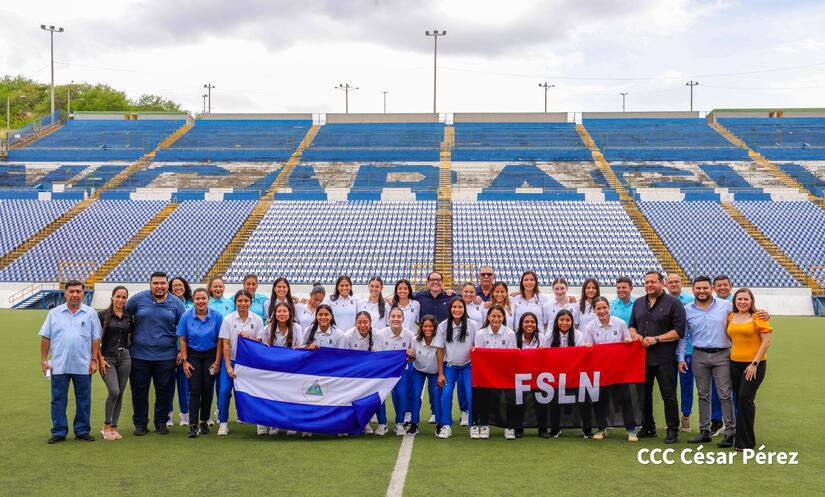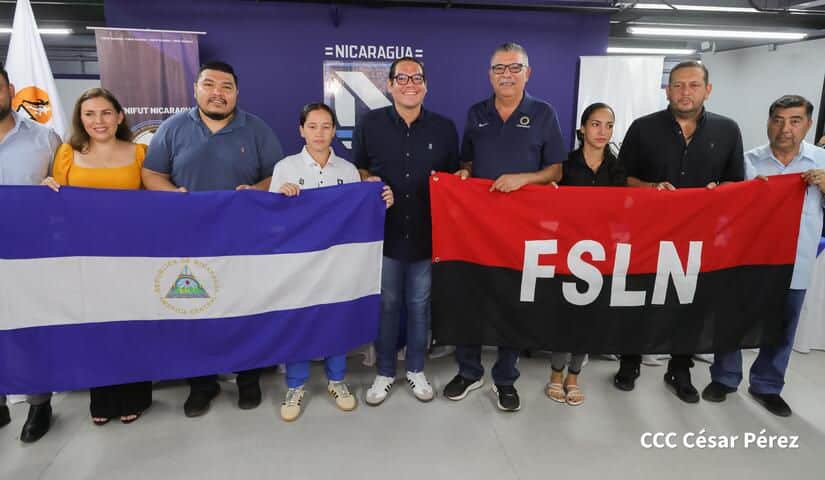For the first time in the history of flag ceremonies for Nicaragua’s national football teams ahead of official FIFA tournaments, the red-and-black flag representing the Sandinista Front party of dictators Daniel Ortega and Rosario Murillo was held by athletes in front of media cameras.
This took place on May 25 during the presentation of the U-20 Women’s National Team at the National Stadium, prior to their participation in the CONCACAF U-20 Championship in Costa Rica. The move—technically prohibited by FIFA—did not go unnoticed in Nicaragua. It stirred concern and unrest about the potential for a future sports sanction.
FIFA’s regulations state in Article 8, Section 3, that political symbols are not allowed at official events. The following section also prohibits clothing bearing political, religious, or personal images. Likewise, FIFA’s statutes specify that affiliated national federations must remain independent, free from the influence of third parties, including governments and political parties.
Given these rules, it would be expected that no affiliated national federation would risk projecting a political symbol that could damage its image or lead to sanctions.
However, the case of the Nicaraguan Football Federation (Fenifut) and the Sandinista regime is unusual—and perhaps even exists in a legal gray area.
The Plot Behind the Use of the Red-and-Black Flag

Divergentes | Taken from pro-government media.
Maurice Ortega Murillo, son of the dictators, arrived at the National Football Stadium accompanied by officials from the Ministry of Youth, Managua’s City Hall, and the Nicaraguan Football Federation (Fenifut) to attend the U-20 Women’s National Team’s flag ceremony.
After a formal speech praising, as usual, the supposed virtues of the Sandinista regime in promoting sports, he took to the synthetic pitch and posed for photos with state media.
In the photo circulated by the regime’s propaganda outlets, Maurice stands in the center; to his right, the blue-and-white national flag of Nicaragua, and to his left, the Sandinista Front’s red-and-black flag. This was the first time the dictatorship’s political symbol appeared at an official FIFA event. Despite being aware of FIFA’s regulations, no one present opposed the imposition of the red-and-black flag.
“I don’t think it was out of ignorance, because it was something unusual that had never been done before. Maybe they just went along with the official narrative, which somehow found a loophole to make the illegal seem legal,” explained a source connected to a government agency overseeing sports, who asked to remain anonymous for safety reasons.
That loophole lies in a gap in FIFA’s own regulations. While the organization doesn’t prohibit national teams from using their official national flag or other patriotic symbols during official presentations, it does enforce strict rules on displaying political or religious messages inside stadiums.
Under this interpretation, the Sandinista regime argues that the red-and-black flag qualifies as a national symbol since it was officially declared as such by the National Assembly—controlled by regime loyalists and puppet allies—in January 2025. This narrative provides the legal pretext, according to the dictatorship, to use it at FIFA events without violating the organization’s rules.
“There were senior national team games before the U-20 flag ceremony, but the red-and-black flag wasn’t used out of caution. It started appearing at other events, but only in lower-profile sports. The real test came with that flag ceremony,” said another source with deep knowledge of national football and close ties to the Sandinista regime.
According to this source, if FIFA imposed a sanction for the use of the red-and-black flag, the regime planned to appeal by arguing the “legality” of its status as a national symbol.
If that excuse failed, they were prepared to accept the punishment, with the understanding that the flag couldn’t be used in higher-profile events—such as the men’s senior team’s World Cup qualifying matches.
Yet, nearly a month after the red-and-black flag was used in an official FIFA-related event, the organization has remained silent, despite the controversy going viral on social media and the flag’s status being only recently imposed in 2025.
“Fenifut is considered independent in FIFA’s eyes. But the real boss hides behind the curtain—and he’ll stay there for the good of football. He doesn’t care about being seen, and as long as things are done his way, everything’s fine. That’s why he stopped being the general manager of Real Estelí—he realized that his visibility could bring the whole thing down,” said the sports insider who spoke with DIVERGENTES.
Fidel Moreno, the football czar ignored by FIFA

The source is referring to Fidel Moreno, secretary general of the Managua City Hall and a close confidant of the Ortega-Murillo regime. Despite no longer being part of the club’s official structure—due to U.S. Treasury Department sanctions imposed in 2018 that prevent him from signing legal documents—Real Estelí’s leadership continues reporting to him.
“Besides running Real Estelí, he also controls the Federation and the First Division League. He’s a politically powerful figure deeply involved in all aspects of national football. Everyone in the country knows it—it’s public knowledge. But since he’s not officially in the structure, I guess that means it’s not illegal,” the source said.
Despite published investigations revealing Moreno’s influence in national football and Real Estelí, as well as corruption in the renovation of Estadio Independencia, where “El Tren del Norte” plays, neither CONCACAF nor FIFA has questioned his involvement—even though their statutes explicitly forbid it.
“When I was on the national team, no political flag was ever used at official events. I don’t know if it was because we had little media coverage back then, or if they knew about the rules—or maybe they just never considered it. But using it now is really strange. I hope it doesn’t lead to any sanctions for Nicaraguan football. That would be a shame, considering all the progress we’ve made,” said a former national team player interviewed by DIVERGENTES for this article.





